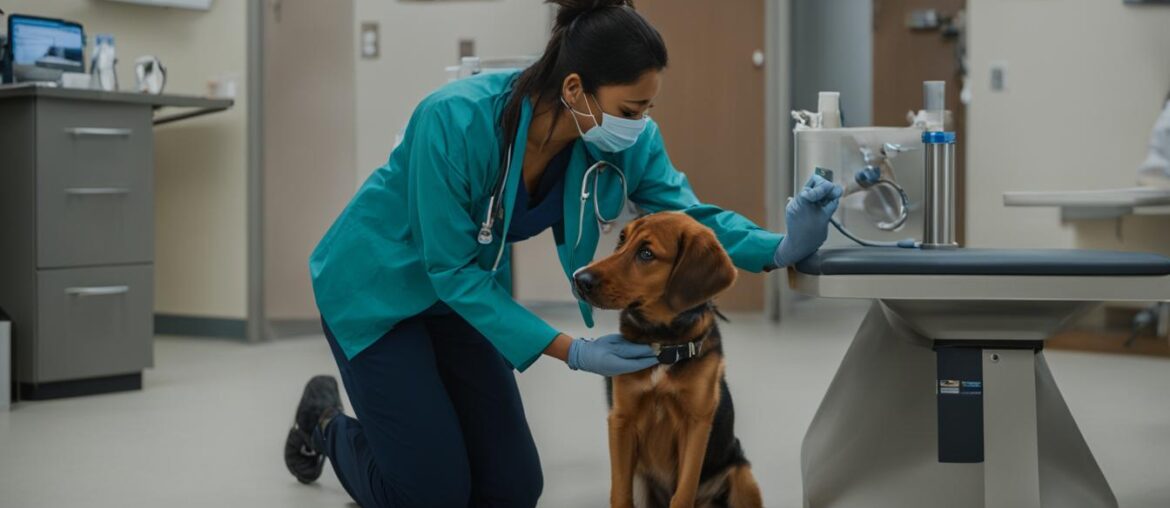Neutering your dog is an important decision that comes with post-surgical care requirements. One crucial aspect is determining when to remove the cone that your dog wears after the procedure. Understanding the timing and importance of cone removal can contribute to your dog’s successful recovery.
Neutering can be performed on dogs anytime after four months of age. The optimal age for neutering depends on various factors, including the size, breed, and genetic history of your dog. Neutering not only prevents unwanted reproduction but also helps reduce undesirable behaviors such as roaming and mounting. Additionally, it can lower the risk of certain cancers and potentially save you money in the long run.
Now, let’s discuss the cone recovery time for dogs after neutering. The cone, also known as an Elizabethan collar or e-collar, should be worn until the incision is completely healed, which usually takes around 14 days. This neck cone acts as a protective barrier, preventing your dog from licking, biting, or scratching the incision site. Removing the cone prematurely can lead to complications and prolong the recovery process.
It is essential to closely monitor your dog’s incision site and behavior before considering cone removal. If the incision looks inflamed, there is any discharge, or if the stitches are visible, it is best to keep the cone on for a more extended period. Always consult your veterinarian for guidance on when it’s safe to remove the cone.
Key Takeaways:
- Neutering can be done after four months of age and offers various benefits, including preventing reproduction and reducing unwanted behaviors.
- The cone should be worn until the incision is completely healed, which typically takes around 14 days.
- Removing the cone prematurely can lead to complications and should be avoided.
- If the incision looks inflamed, shows discharge, or the stitches are visible, it is best to keep the cone on for a longer period.
- Consult your veterinarian for guidance on when to safely remove the cone.
Benefits of Neutering Your Dog
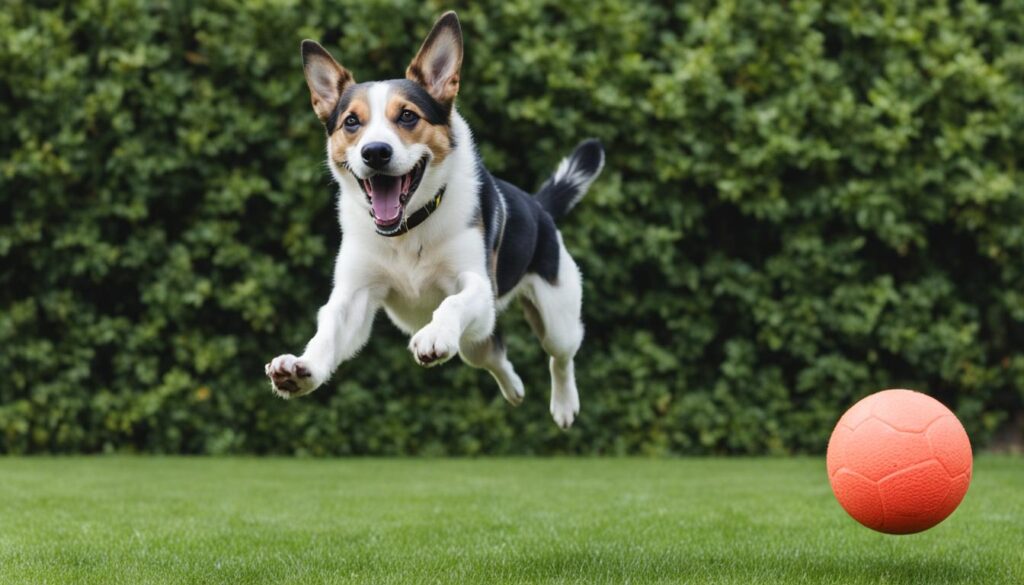
Neutering your dog offers several significant benefits that contribute to their overall well-being. By choosing to neuter your dog, you are taking a responsible step that not only prevents unwanted litters but also provides numerous advantages for their health and behavior.
Reduced Behaviors and Health Benefits
- Prevents reproduction and the responsibilities that come with having puppies.
- Reduces undesirable behaviors such as roaming and mounting.
- Decreases the risk of testicular cancer.
- Eliminates the risk of uterine infections and reduces the likelihood of mammary gland tumors in females.
- Saves money in the long run by minimizing the expenses associated with breeding, including veterinary care, food, and shelter for puppies.
Contrary to common misconceptions, neutering has no impact on weight gain or personality changes. Neutered dogs maintain their distinct personalities and are less likely to exhibit problematic behaviors like urine marking or aggression.
Neutering your dog not only benefits them but also positively impacts the larger community by reducing the number of stray and homeless animals. It is important to consult with your veterinarian to determine the best age and timing for neutering your dog, taking into consideration factors such as breed, size, and health status.
The Importance of the E-collar
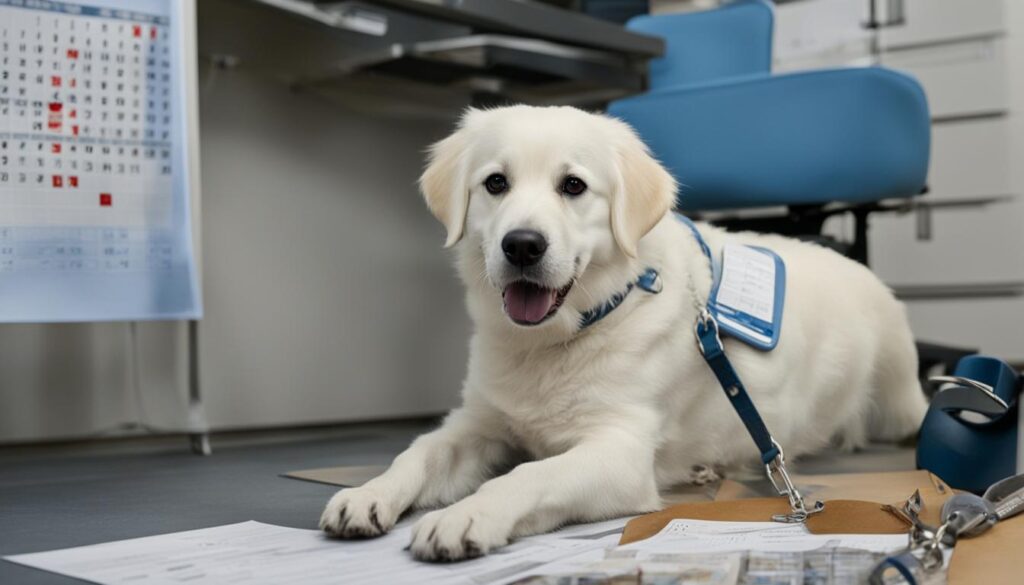
After neutering, dogs are typically sent home with an Elizabethan collar or e-collar. The e-collar plays a vital role in ensuring the dog’s recovery and preventing complications.
The primary purpose of the e-collar is to prevent the dog from licking or biting at the incision site during the healing process. By restricting access to the surgical area, the e-collar ensures that the incision heals properly and reduces the risk of infection or injury.
The e-collar should be worn for the recommended duration, usually about 14 days or until the veterinarian advises otherwise. It is crucial not to remove the e-collar prematurely, even if the dog appears uncomfortable. Doing so can lead to excessive licking or biting, which can result in reopening the incision or introducing harmful bacteria, prolonging the recovery period.
The benefits of using an e-collar after surgery extend beyond preventing self-inflicted harm. The e-collar can also deter other pets or objects from coming into contact with the surgical area, further reducing the risk of complications.
While wearing an e-collar may initially be stressful for dogs, it is essential for their safety and successful recovery. The discomfort experienced during the healing process is temporary and outweighed by the long-term benefits of proper wound healing and reduced risk of complications.
Benefits of the E-collar:
- Prevents licking and biting at the incision site
- Ensures proper healing of the incision
- Reduces the risk of infection or injury
- Deters other pets or objects from coming into contact with the surgical area
By following the veterinarian’s instructions and ensuring the dog wears the e-collar for the recommended duration, owners can contribute significantly to their furry friend’s successful recovery.
When to Remove the Cone
The cone should generally be removed seven days after the neuter surgery. However, the timing may vary depending on factors like the condition of the incision and the dog’s behavior. Before removing the cone, it’s important to assess if the dog tends to lick at his skin, if the incision site looks inflamed, if there is any discharge, or if the stitches are visible. If any of these conditions are present, the cone should be left on for a longer period.
Managing Post-Neuter Care
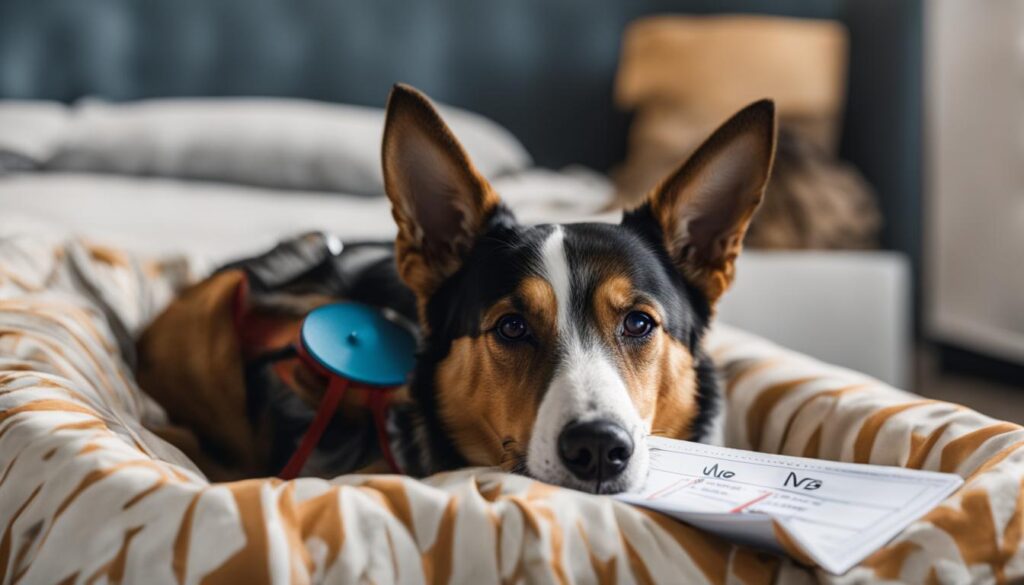
After your dog has been neutered, it’s important to provide proper post-neuter care to ensure a smooth healing process. Here are some essential tips to help your dog recover after neutering:
- Avoid giving baths: It’s crucial to keep the incision site dry to promote healing. Avoid giving your dog baths until the incision is completely healed.
- Limit exercise: For the first few days after the surgery, restrict your dog’s activity to short on-leash walks. Avoid rough playing or any strenuous activity that may strain the healing incision.
- Prevent irritation: Keep your dog away from other pets during the recovery period. This will help prevent any irritation or injuries to the incision site that could delay the healing process.
- Monitor the incision: Regularly check the incision site for any signs of infection, such as redness, swelling, or discharge. If you notice any negative side effects, contact your veterinarian for further guidance.
Tips for Cone Use and Comfort
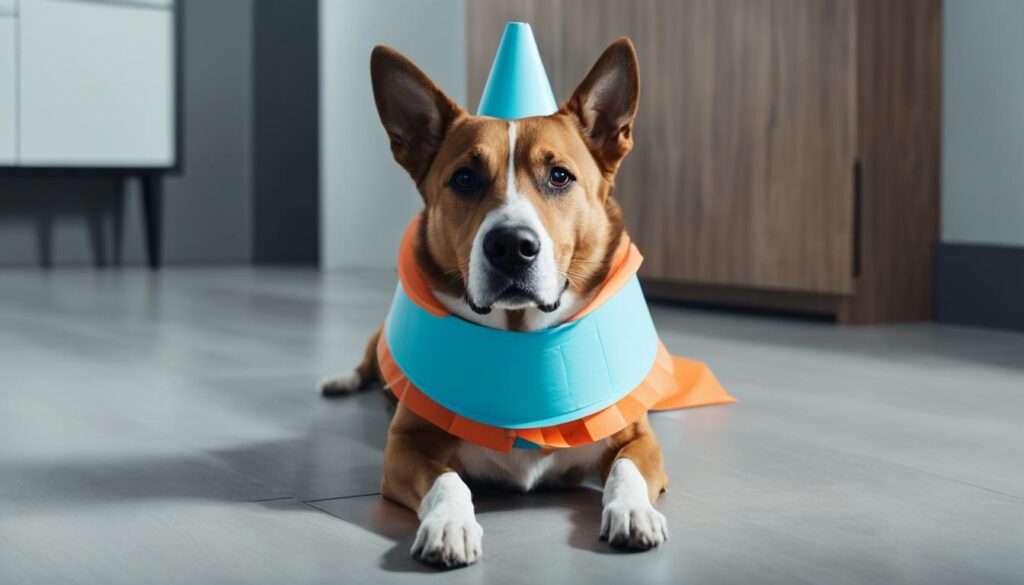
Dogs often find wearing a cone uncomfortable, but there are ways to make it more tolerable. Here are some helpful tips:
Choose the Right Size
When selecting an e-collar for your dog, make sure it is the right size. A cone that is too tight can cause discomfort, while a cone that is too loose may allow your dog to reach the surgical site. Measure your dog’s neck circumference and choose an e-collar that fits snugly without being too tight.
Monitor Closely
After putting on the e-collar, closely monitor your dog for the first few hours. Observe for signs of depression, lethargy, or your dog bothering the surgical site. If you notice any concerning behavior, put the cone back on and contact your veterinarian for guidance.
Consider Alternative Options
If your dog is having difficulty adjusting to the traditional e-collar, there are alternative options available. Inflatable donuts and BiteNot Pet Collars are alternatives that provide a more comfortable experience while still preventing your dog from reaching the surgical site.
| Tip | Description |
|---|---|
| Choose the Right Size | Ensure the e-collar fits properly around your dog’s neck to maximize comfort and effectiveness. |
| Monitor Closely | Keep a close eye on your dog’s behavior and the surgical site for any signs of discomfort or complications. |
| Consider Alternative Options | If your dog is struggling with the traditional e-collar, explore alternative options that provide a more comfortable experience. |
Keeping Your Dog Comfortable during Sleep

Ensuring that your dog can sleep comfortably with the e-collar on is essential for their recovery after neutering. While your dog may initially feel confused or uncomfortable, they will eventually find a way to rest. Most e-collars are flexible enough to allow your dog to shift or bend when lying down, allowing for greater comfort during sleep.
If your dog normally sleeps in a crate, consider providing multiple resting areas around your home where they can find a comfortable spot. This will give them options and help alleviate any stress or discomfort caused by the cone. Additionally, using soft bedding or pillows can provide extra comfort for your furry friend while they sleep.
Following your veterinarian’s instructions is crucial during this time. It’s important to continue maintaining the e-collar when your dog is sleeping to ensure their safety and prevent any unnecessary complications. Remember, the cone is a crucial component of their recovery, and proper use will help promote a safe and comfortable healing process.
Some dogs may take some time to adjust to sleeping with the e-collar, but with patience and understanding, they will eventually adapt. Remember to monitor your dog’s behavior and consult your veterinarian if you notice any signs of distress or discomfort during sleep.
Tips for Post-Neuter Care
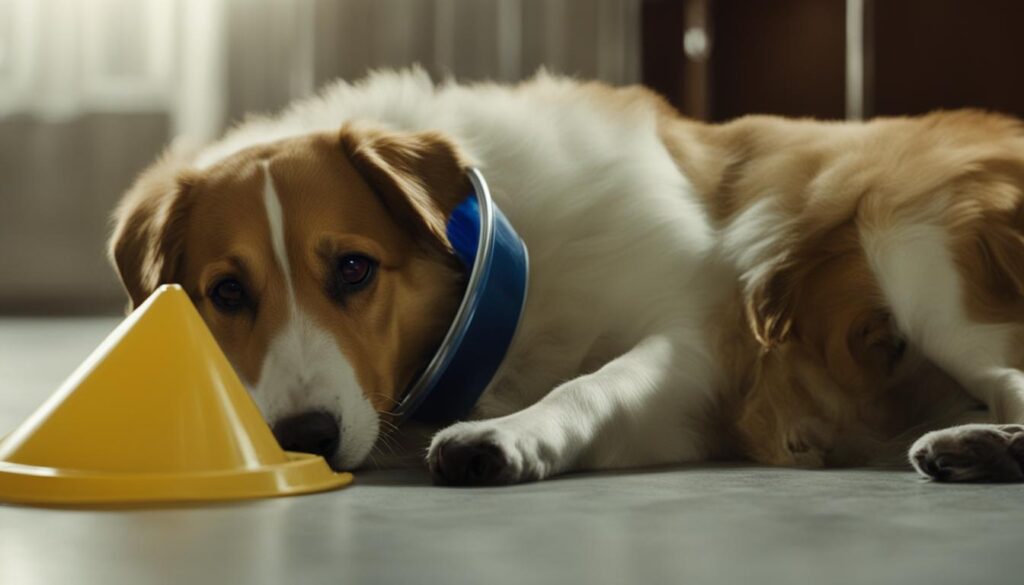
After a dog has been neutered, proper post-operative care is crucial for a smooth and successful recovery. Here are some essential tips to help manage your dog’s healing process and ensure their well-being:
- Keep the Incision Dry: Avoid giving your dog baths until the incision is completely healed. Moisture can interfere with the healing process and increase the risk of infection.
- Limited Exercise: To prevent complications, limit your dog’s physical activity, especially during the initial days of recovery. Short leash walks are sufficient for exercise but avoid strenuous activities or long walks.
- Isolation from Other Pets: It’s crucial to keep your dog away from other pets during the healing process. Playful interactions or unintentional injuries from other animals can disrupt the incision site and impede the recovery process.
- Monitor the Incision: Regularly inspect the incision site for any signs of redness, swelling, discharge, or abnormalities. If you notice anything concerning, contact your veterinarian immediately.
- Follow Veterinarian’s Instructions: Adhere closely to the post-neuter care instructions provided by your veterinarian. They may recommend specific medications, dietary restrictions, or additional precautions to promote healing and overall well-being.
- Watch for Negative Side Effects: Pay attention to any unusual behavior or negative side effects that may occur during the recovery process. Changes in appetite, excessive lethargy, or persistent discomfort should be promptly reported to your veterinarian.
By following these post-neuter care tips, you can help manage your dog’s recovery and ensure a smooth healing process. Remember, keeping the cone on until the incision is fully healed is essential for proper recovery.
Sample Table for Monitoring Incision
| Date | Incision Status | Notes |
|---|---|---|
| Day 1 | No redness or swelling | |
| Day 3 | Slight redness | Applied topical ointment as advised by the vet |
| Day 5 | Incision looking clean | |
| Day 7 | Incision fully healed | Consulted vet for cone removal |
The Importance of the Cone
The cone, also known as an Elizabethan collar or e-collar, plays a crucial role in the recovery process after dog neutering surgery. Its purpose is to protect the incision site and prevent the dog from licking, biting, scratching, or rubbing the area. By acting as a barrier, the cone reduces the risk of infections and complications that could arise from the dog’s interference with the healing process.
Wearing the cone is essential for the dog’s safety and successful recovery. It ensures that the dog cannot access the incision site with its mouth, minimizing the risk of introducing bacteria or causing further damage. The cone also prevents the dog from irritating the area, promoting proper healing and reducing the likelihood of complications.
Dogs may initially find wearing the cone uncomfortable or strange, but it is vital to keep it on until the incision is fully healed. Monitoring the dog’s behavior and making adjustments for comfort, such as using soft padding or adjusting the fit of the cone, can help alleviate any distress the dog may experience during its recovery journey.
In conclusion, the cone serves an important role in the post-neuter care of dogs. It provides a protective barrier, allowing for a safe and uneventful recovery. By understanding the importance of the cone and diligently following the veterinarian’s instructions, dog owners can ensure their furry friends heal successfully and quickly after neutering surgery.
Wrapping Up
After neutering, it’s crucial to adhere to the veterinarian’s instructions and keep the cone on your dog until the incision is fully healed, which typically takes around 14 days. Prematurely removing the cone can result in complications and extend the recovery period. It’s important to regularly monitor your dog’s behavior and the incision site for any signs of infection or discomfort. If you have any concerns, seek guidance from your veterinarian.
By providing proper post-neuter care and ensuring your dog’s comfort with the e-collar, you can contribute to a safe and comfortable recovery. Remember to follow the recommended dog cone removal timeline, which should be determined by your veterinarian. Managing cone use after dog neuter is crucial for preventing your dog from interfering with the incision area and leading to potential complications.
When the time comes for cone removal after dog neuter, it’s essential to do it with care. Gradually transition your dog to cone-free life by closely observing their behavior. If your dog does not show signs of excessive licking or irritation, you can consider removing the cone under the guidance of your veterinarian. Always prioritize your dog’s well-being and take into account their individual healing process when deciding on cone removal. Remember, your veterinarian is your best ally in providing the best care for your furry friend during their post-neuter recovery.
FAQ
When should I take the cone off my dog after neutering?
The cone should be worn until the incision is completely healed, usually for about 14 days. Removing the cone prematurely can lead to complications.
What are the benefits of neutering my dog?
Neutering prevents reproduction and reduces unwanted behaviors such as roaming and mounting. It also lowers the risk of certain cancers and saves money in the long run.
Why is the E-collar important after neutering?
The E-collar, or cone, is important to prevent licking or biting at the incision site during the healing process. It ensures that the incision heals properly and reduces the risk of complications.
When should I remove the cone after my dog’s neuter surgery?
The cone should generally be removed seven days after the neuter surgery. However, the timing may vary depending on factors like the condition of the incision and the dog’s behavior.
How can I manage post-neuter care for my dog?
After neutering, avoid giving baths until the incision is completely healed. Limit exercise to short leash walks and keep the dog away from other pets to prevent irritation or injuries to the incision site.
What are some tips for cone use and comfort for my dog?
Choose an E-collar that fits properly and monitor your dog closely for any signs of discomfort or depression. There are alternative options to the traditional cone, such as inflatable donuts or BiteNot Pet Collars.
How can I help my dog sleep comfortably with the cone on?
Most E-collars are flexible enough to allow the dog to shift or bend when lying down. Provide multiple resting areas around the home where the dog can find a comfortable spot.
What are some tips for post-neuter care for my dog?
Regularly monitor the incision for signs of infection and contact the veterinarian if any concerns arise. Follow the veterinarian’s instructions closely and seek guidance if any negative side effects emerge.
Why is the cone important after my dog’s neuter surgery?
The cone, also known as an Elizabethan collar or E-collar, is important for protecting the dog’s incision site. It prevents licking, biting, pawing, scratching, or rubbing of the area, reducing the risk of infection or complications.
What should I know about cone removal for my dog after neutering?
Remove the cone only after the incision is fully healed, as advised by the veterinarian. It is important to manage cone use and follow the recommended timeline to ensure a safe and comfortable recovery for your dog.


